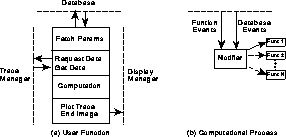




Next: 18.2.11 Prototype System
Up: ISIS: An
Interactive
Previous: 18.2.9 User Interface
The computational process consists of two parts: the system-level
framework, and the user-defined, application-level processing functions.
The user-defined functions perform the seismic imaging tasks and are free to
pursue that end by whatever means the applications programmer finds
appropriate, as long as the functions return normally and in a timely
fashion. Figure 18.7a is a schematic example of a typical
user-defined function. The user function, when called, first retrieves any
relevant parameters from the database. These parameters may be processing
parameters, such as the velocity model, or they may be special information,
such as a specification of the data to be processed. After retrieving the
parameters, the function requests the appropriate data from the trace
manager through a call to datarequest. It then loops over calls to
getdata, performs computations, and executes the appropriate calls to
plot the processed traces. The function may loop over several data requests
if multiple gathers are needed, for instance, to build a stacked section.
The function notifies the display manager when the image is complete, and the
user function returns to the calling process.

Figure 18.7: An Instance of a Computational Process: (a) a User-Defined
Function; (b) the Controlling Process with Several User Functions in Place.
The bold arrow running from the notifier to the user function ``Func 1''
indicates the currently active function.
While the parallelism of the computational process cannot be hidden
from the applications programmer, the programming task is made much
simpler by concealing the implementation details of the trace manager,
display manager, and database. To help facilitate parallelization,
each instance of a computational process is provided with the total
number of computational processes, as well as its own logical position
in that number. With this information, most seismic imaging tasks can
be easily parallelized by either data or domain decomposition.
The system-level software for the computational processes
(Figure 18.7b) consists of a main notifier loop that handles the
database events and distributes control to the user-defined functions. The
programmer is provided with functions for registering the processing
functions with the notifier, along with the databases
of interest to those functions. For instance, a function to plot shot
gathers may depend on the statics database only, while a function to
produce a stacked section may depend on the velocity database and the
statics database. The applications programmer is also provided with an
interface for selecting the active function. No more than one function
may be active at any given time. Incoming database events are consumed
by the notifier, the data are stored in the local database, and the
notifier will call the active function if and only if that function has
registered an interest in that particular database. This interface
simplifies adding a new processing function or parameter to the
existing system.





Next: 18.2.11 Prototype System
Up: ISIS: An
Interactive
Previous: 18.2.9 User Interface
Guy Robinson
Wed Mar 1 10:19:35 EST 1995





